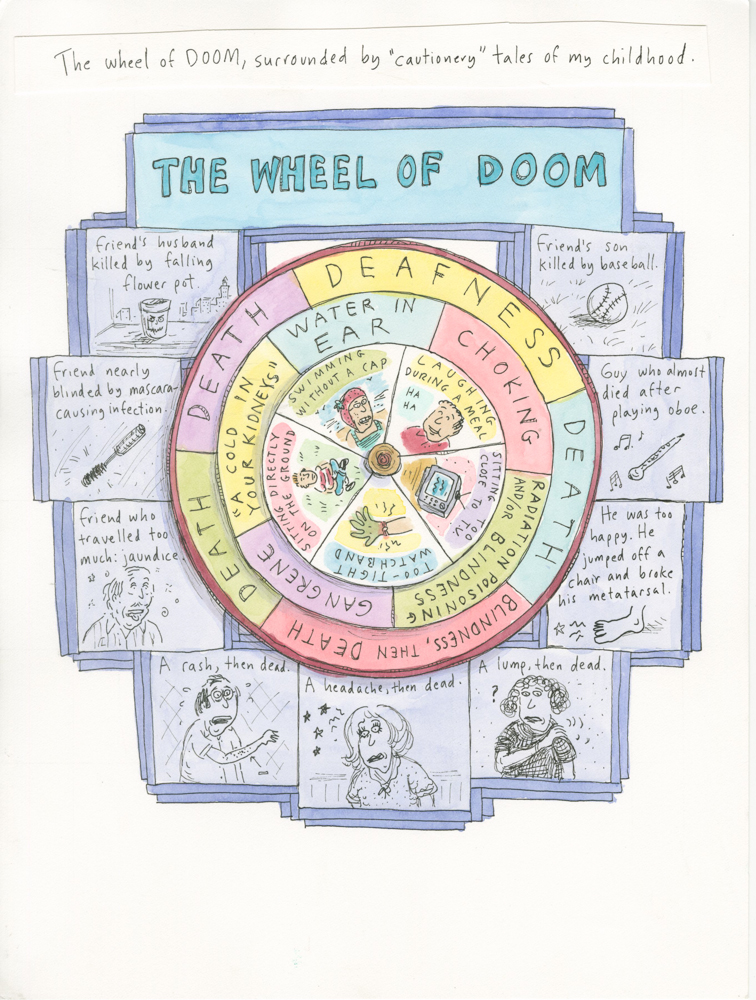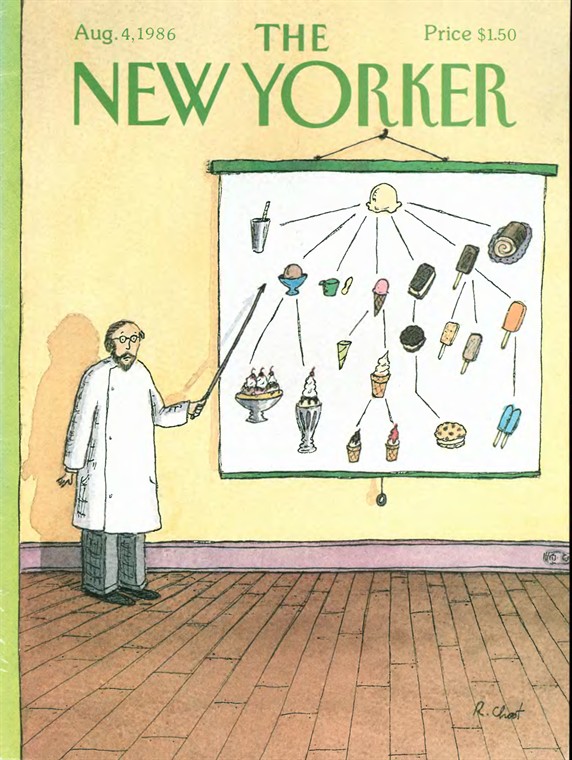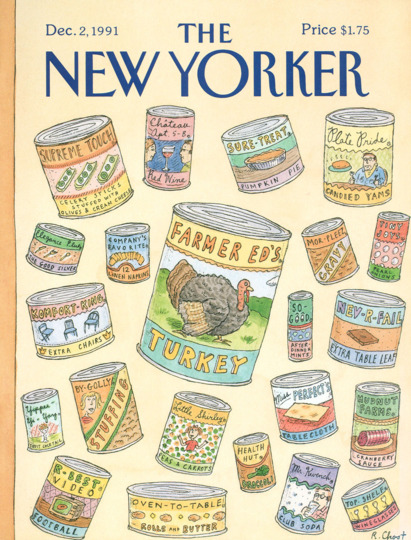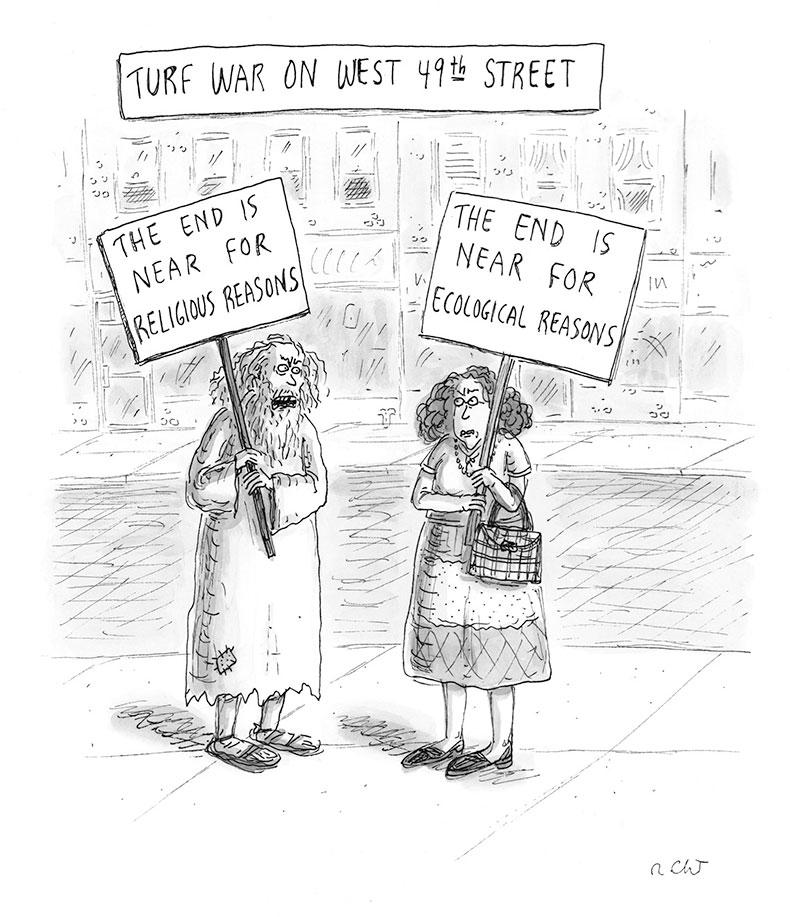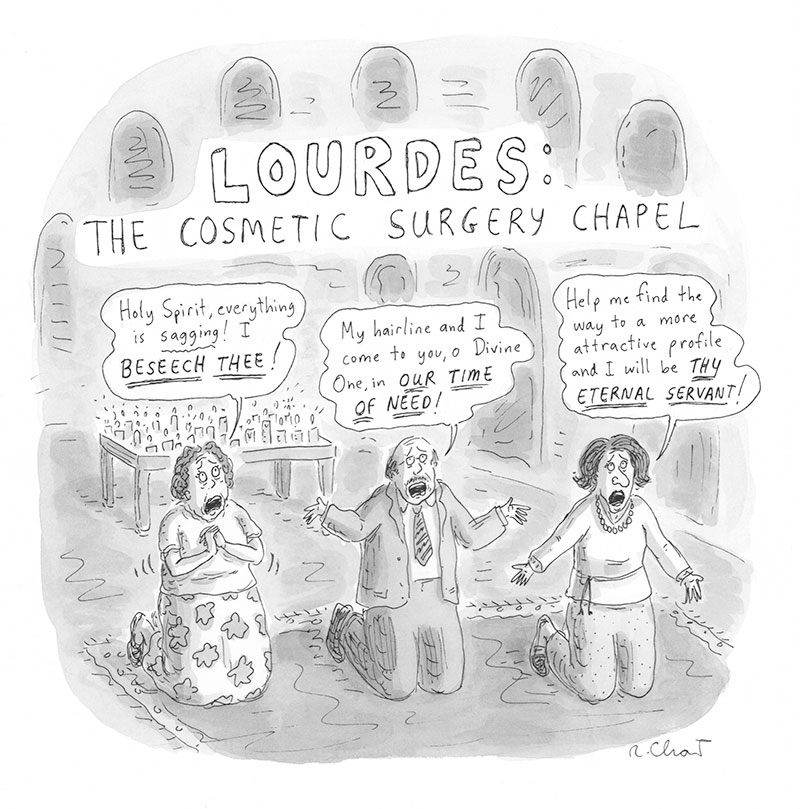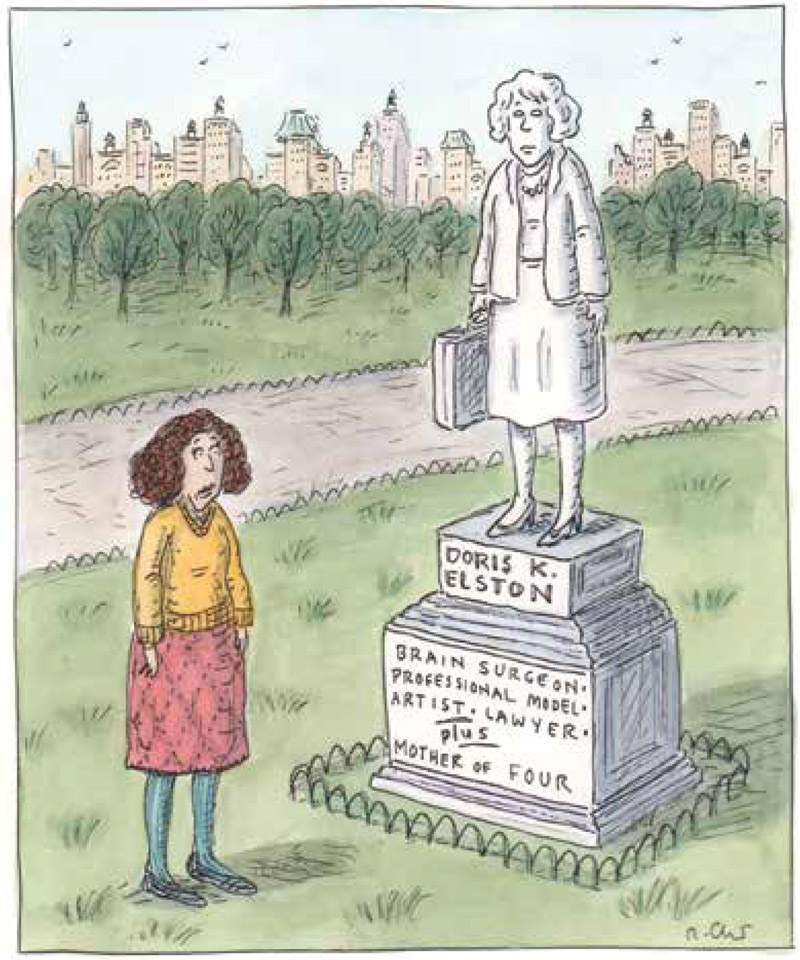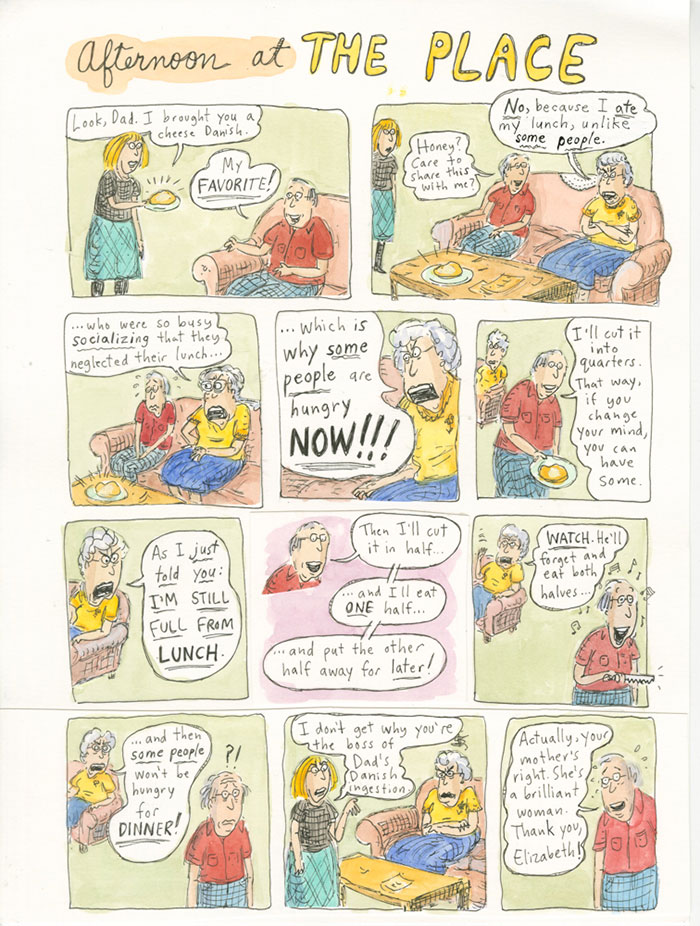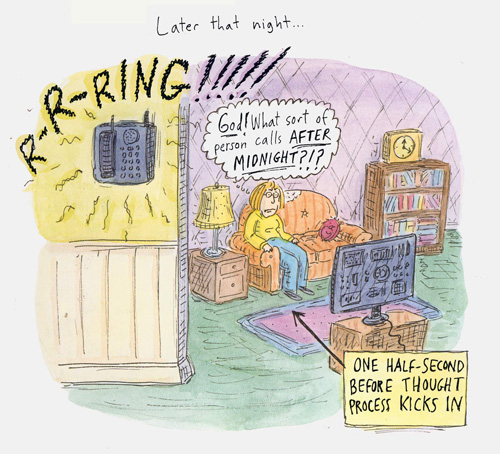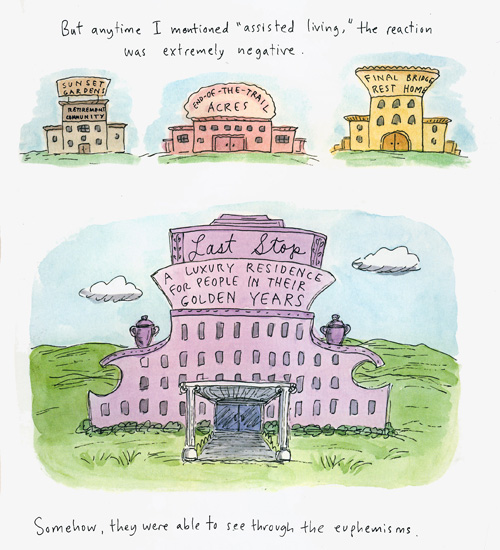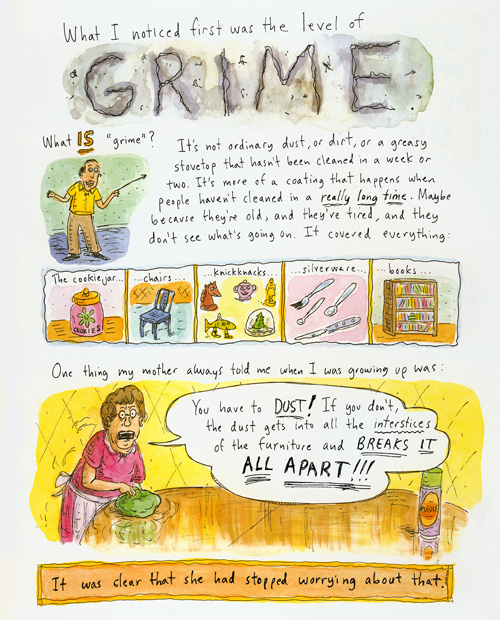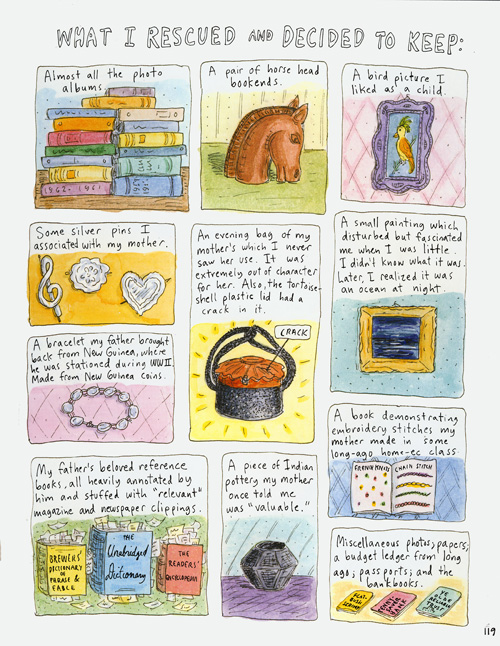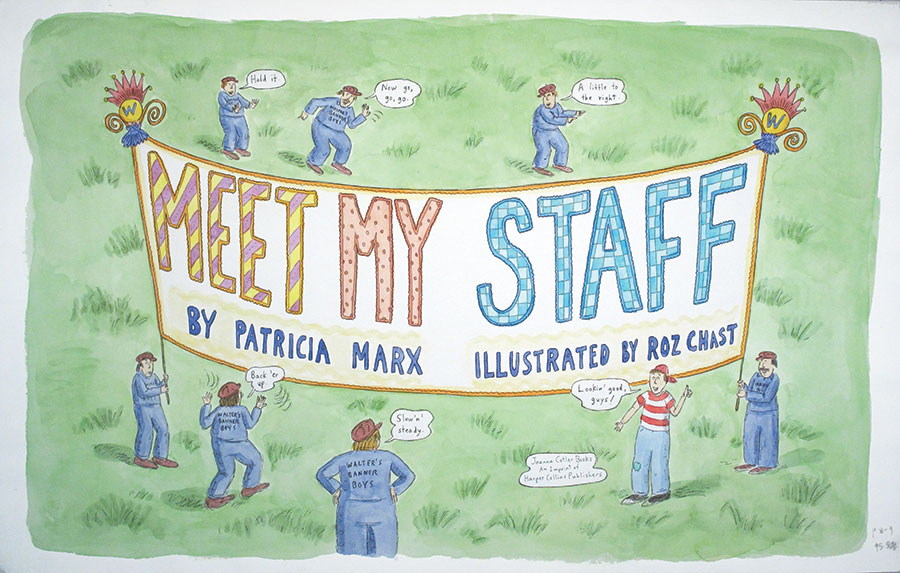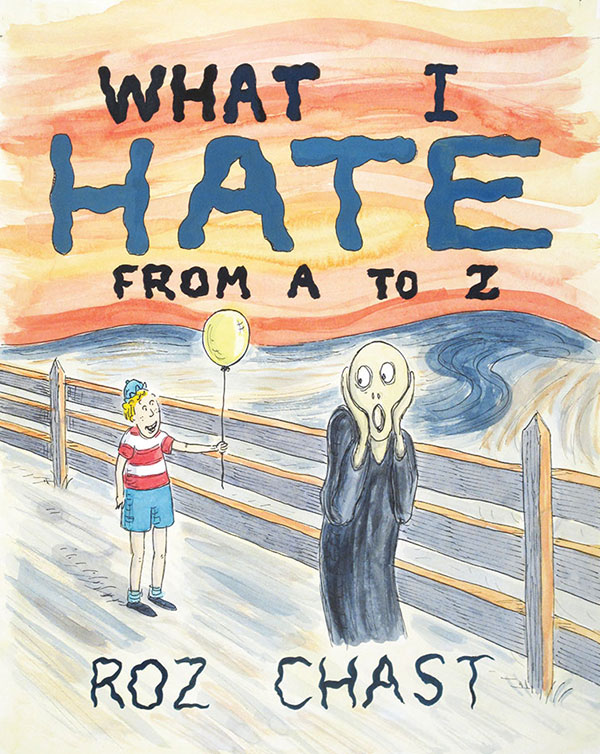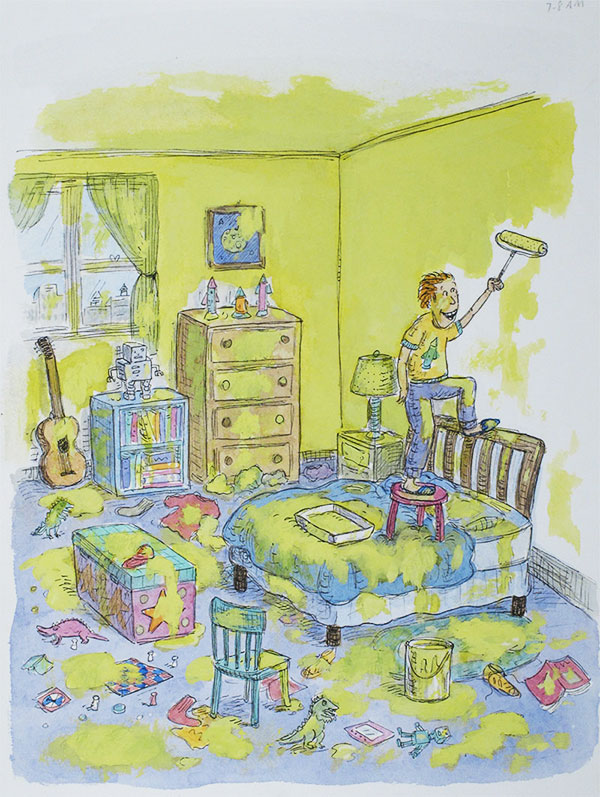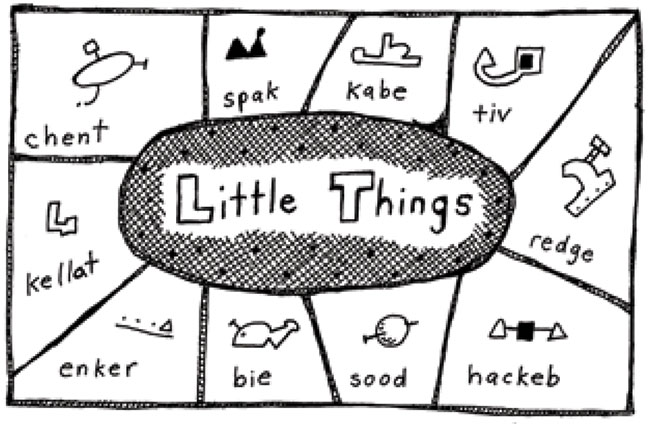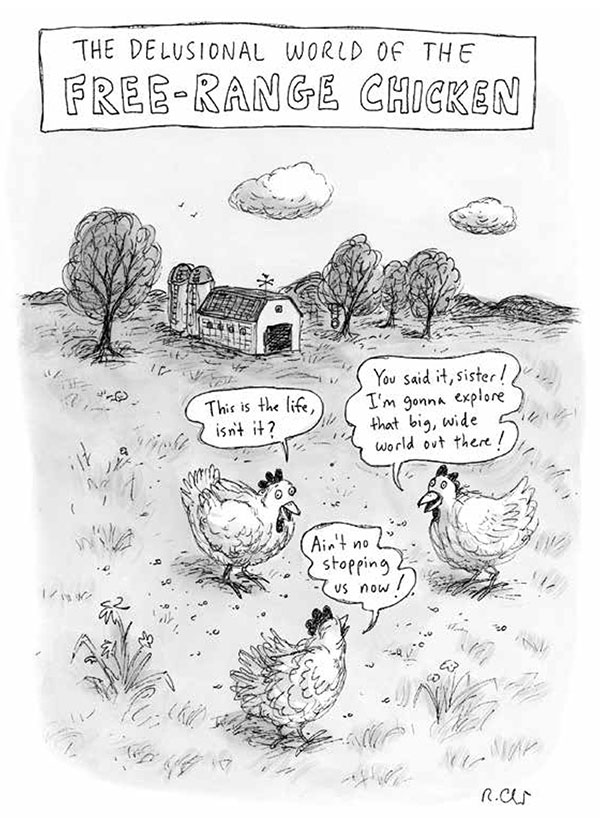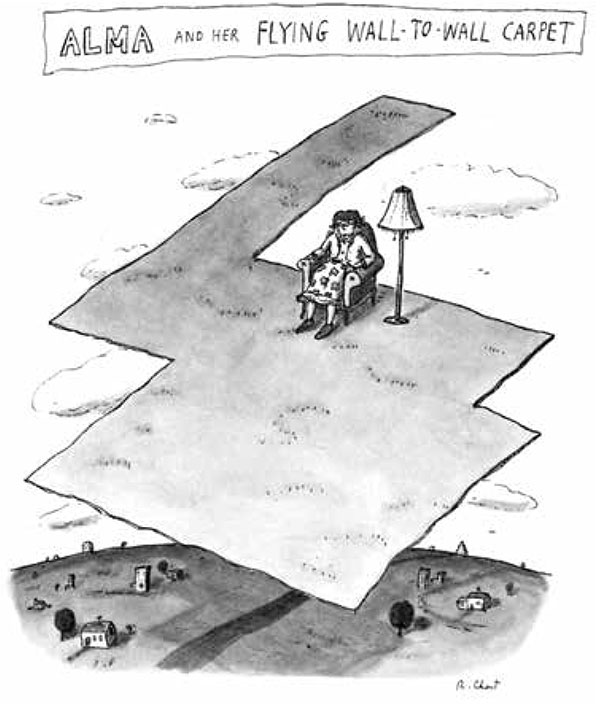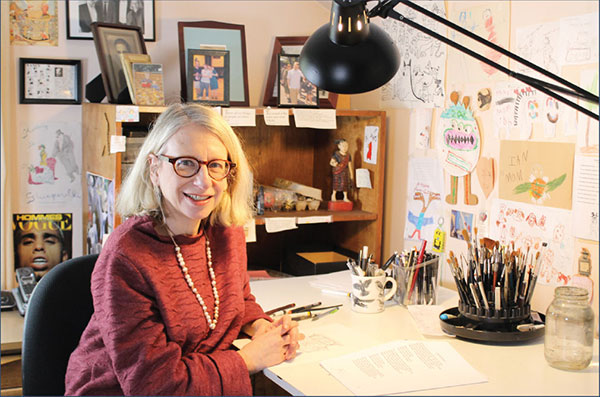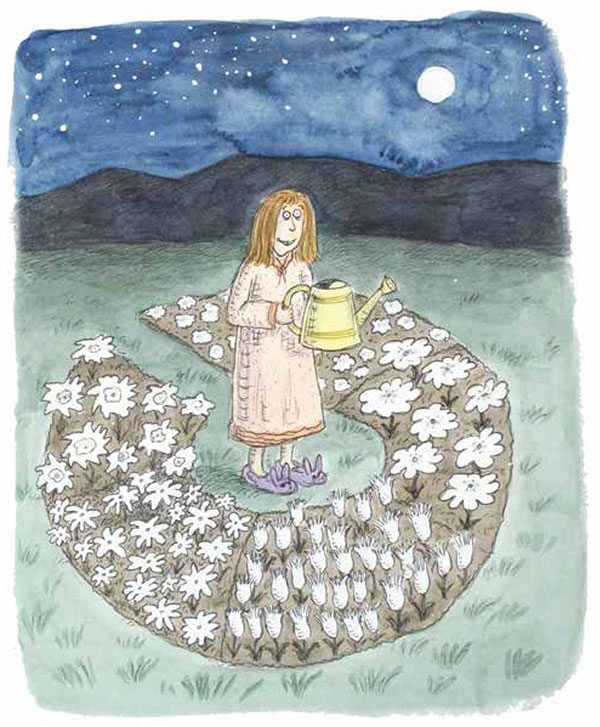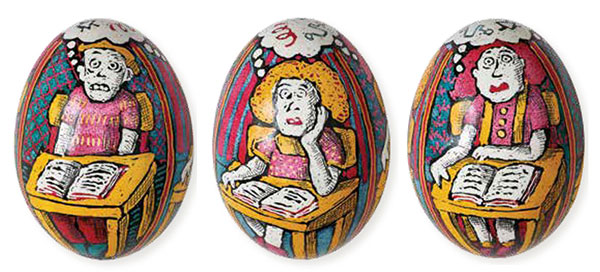
What People are Saying about Roz Chast: Cartoon Memoirs
“Just like at a good movie, I laughed, I cried, I got hungry. We left satisfied…”
“…little bit manic and extremely funny…”
“Roz Chast came out drawing. She admits as much.”
“If anyone could pull laughs from the burden of caring for aging parents, it would be Roz Chast”
“Will include a lot of personal memorabilia and photographs that should resonate with Chast’s fans”
In her first memoir, long-time New Yorker cartoonist Roz Chast brings her signature wit to the topic of aging parents. Spanning the last several years of their lives and told through four-color cartoons, family photos, and documents, and a narrative as rife with laughs as it is with tears, Chast’s memoir is both comfort and comic relief for anyone experiencing the life-altering loss of elderly parents. When it came to her elderly mother and father, Roz held to the practices of denial, avoidance, and distraction. But when Elizabeth Chast climbed a ladder to locate an old souvenir from the “crazy closet,” with predictable results, the tools that had served Roz well through her parents’ seventies, eighties, and into their early nineties could no longer be deployed.
While the particulars are Chast-ian in their idiosyncrasies, focusing on an anxious father who had relied heavily on his wife for stability as he slipped into dementia, and a former assistant principal mother whose overbearing personality had sidelined the artist for decades, the themes are universal: adult children accepting a parental role; aging and unstable parents leaving a family home to live within the confines of an institution; dealing with uncomfortable physical intimacies; managing logistics; and hiring strangers to provide the most personal care. An amazing portrait of two lives at their end and an only child coping as best she can, Something More Pleasant will show the full range of Roz Chast’s talent as cartoonist and storyteller. The exhibition will also feature additional artworks representing the breadth of the artist’s career, including her legendary art for The New Yorker, children’s picture books, intricately-painted eggs, and hand-made storytelling rugs.
Born in Brooklyn, New York, Roz Chast is the only child of two educators who subscribed to The New Yorker and inspired her art and world view – her strong-willed mother, Elizabeth, and her gentle, worrywart father, George, who were in the same fifth grade class. Chast studied painting and printmaking at Kirkland College in upstate New York, and received her Bachelor of Fine Arts degree from Rhode Island School of Design, but did not feel free to explore car- tooning fully until after graduation. Her earliest drawings were published in Christopher Street,The Village Voice, and later, National Lampoon.
In 1978, The New Yorker accepted her first submission, a small collection of “Little Things” that stood apart from the cartoons generally associated with the magazine. As a young artist, she gathered a collection of original drawings, “put them in a portfolio, and dropped it off with my little card. I came back to pick them up the next week and there was a note from the cartoon editor [Lee Lorenz], which completely floored me. He said to start coming back every week, so I did.” Since then, more than eight hundred of Chast’s artworks have been published by The New Yorker. Though she covers all manner of subjects in her art, she particularly enjoys drawing interior scenes, replete with elaborate wallpapers and furnishings – a conspiracy of inanimate objects” reminiscent of her early life. Chast’s cartoons have also appeared in Scientific American, the Harvard Business Review, Redbook, and Mother Jones, among others.
When I’m drawing, I’m thinking “what do I think is funny, what’s making me laugh, what’s getting to me?”
Her first graphic memoir, Roz Chast’s Can’t We Talk About Something More Pleasant? has garnered acclaim for its grimly funny and deeply poignant exam- ination of end-of-life issues as she experienced them with her elderly parents. Dedicated professional educators before their retirement, Elizabeth and George Chast were temperamentally dissimilar but intensely devoted to one another. The artist’s poignant tale, punctuated by moments of hilarity, traces their physical and cognitive decline, from “The Beginning of the End” to “The End,” examining the complexities of her relationship with them through the years.
A 2014 National Book Award Finalist for Non-Fiction, Can’t We Talk About Something More Pleasant? is also the winner of the prestigious National Book Critics’ Circle Award for Autobiography and the Kirkus Prize for Non-Fiction. The book, and Chast’s artistic contributions, were recognized in 2015 with a Heinz Award for Arts and Humanities. Of the effort, Chast notes that, “I didn’t want to forget how they talked and I didn’t want to forget how they were….Some of the stories that emerged were hilarious, but also heartbreaking, and they became a record of my experience with them. To know that others felt the book meant something to them – I’m very happy about that.”
My cartoons tell the story of things that have happened in my life.
Roz Chast’s art has appeared in almost twenty books, including collections of published cartoons and original picture book for children. “For children’s books, I’ve illustrated other people’s stories, and I’ve also done my own,” she said.”Creating images for kids is a little different than doing drawings for adults,but I think there is overlap, a Venn diagram aspect.” As the mother of two, she has a sense for what might be appealing. “There are certain jokes that I know kids will get. I don’t think any of my children’s books talk down to kids. I might not use complicated language, but it’s kind of fun to put in a few words they may not know. They can always ask their parents.”
Chast’s lighthearted illustrated books include 101 Two-Letter Words, What I Hate from A to Z, The Alphabet from A to Y with Bonus Letter Z, Too Busy Marco, Marco Goes to School, and Unscientific Americans, among others. In 2012, she was awarded the New York City Literary Honor in Humor by Mayor Michael Bloomberg.
The wonderful thing about the cartoon form is that it’s a combination of words and pictures. You don’t have to choose, and the two are often greater than the sum of their parts.
My cartoons tell the story of things that have happened in my life, like odd conversations and people I have met.
Like many readers of The New Yorker and other popular publications, I have always been drawn to Roz Chast’s singular wit, and look forward to each new cartoon recounting the exploits of characters whom I feel I have come to know. Inspired, as Norman Rockwell was, by life’s small moments, her intelligent, expressive drawings prove that fact can be stranger than fiction, and that one need not go far to find comic relief in our crazy, irrepressible world.
Norman Rockwell Museum is honored to present the art of this distinguished illustration master in Roz Chast: Cartoon Memoirs, celebrating almost four decades of outstanding artistic accomplishment. The exhibition offers the first presentation of original works from her acclaimed visual memoir, Can’t We Talk About Something More Pleasant?, which chronicles the lives of her aging parents with heartfelt humor and emotion. The full range of the Chast’s talents and the breadth of her career are also revealed in her legendary cartoons for The New Yorker; book illustrations for Around the Clock, What I Hate from A to Z, Marco Goes to School, and 101 Two-Letter Words, among others; intricately-painted Ukrainian character eggs; and one-of-a-kind hand-made storytelling rugs.
The Distinguished Illustrator Exhibition Series honoring the unique contributions of exceptional visual communicators is presented by the Rockwell Center for American Visual Studies, the nation’s first research institute devoted to the art of illustration. The Distinguished Illustrator series reflects the impact and evolution of published art, and of Norman Rockwell’s beloved profession, which remains vibrant and ever-changing.
Stephanie Haboush Plunkett
Deputy Director/Chief Curator
Norman Rockwell Museum
As an art form that is almost a century old, The New Yorker cartoon provides a unique window on our culture. It’s possible to focus in on an individual cartoonist and look at their work for insight into creativity and into the times in which their work was published. Roz Chast’s drawings began appearing in The New Yorker at an interesting time in the country and at the magazine; and her work widened our understanding of what humor can be.
The New Yorker was founded as a humor magazine in 1925, and over the course of the first year, founder Harold Ross and his editors and artists worked together to create what we now know as The New Yorker cartoon: often subtle, ironic, sometimes political, often sophisticated. The cartoon has evolved and certain forms have found favor at different times over the course of the magazine’s history.
The first few years, there were all kinds of cartoons – single panels with two captions, comic strip – like sequential cartoons and caption-less cartoons. The editors often toyed with the layout: there were odd-shaped cartoons that were creatively surrounded by text, drawings that were as tall as the page, others traveled across double page spreads.
Everybody has a different line, a different sense of humor. It’s a great medium, I just love cartoons.
In an interview conducted on March 13, 2015, we had the opportunity to speak with Roz Chast about her prolific career, and about her place as one of America’s most beloved cartoonists.
Did you draw as a child, and was art encouraged in your youth?
I can’t remember when I wasn’t drawing, it was always something I liked to do. Sometimes my parents or teachers would say, oh, that’s a nice drawing, and it would make me want to do more. When you’re a kid, it may not be articulated, but you start to get a sense of who you are.
When did the concept of being a cartoonist emerge for you?
Over the summers, my parents would spend time in upstate New York at Cornell [University] with a group of Brooklyn schoolteachers, who were there to attend seminars. The student building on campus had a browsing library, and there was a section filled with cartoon books. That’s where I first saw the drawings of Charles Addams, and I became obsessed with them because they made me laugh. I looked at those books over and over again, and I just loved them. Later, I don’t think I ever thought about having a career as a cartoonist. I just thought, this is all I can do. It never occurred to me that I would do anything else. I did not want to work in a school, cash registers frightened me, and I wasn’t good at listening to instructions. The only thing I really thought I could do was work by myself and draw, and that is what I do.
Cartoon Memoirs: An Evening with Roz Chast
New Yorker cartoonist Roz Chast takes a lively look at her prolific career, and her acclaimed graphic memoir, “Can’t We Talk About Something More Pleasant?”
Event took place on July 9, 2015 – 5:30PM
Norman Rockwell Museum
© Norman Rockwell Museum. All rights reserved.
Roz Chast: Cartoon Memoirs
Video produced by Jeremy Clowe for the exhibit “Roz Chast: Cartoon Memoirs” at the Norman Rockwell Museum.
June 6 through October 26, 2015.
© Norman Rockwell Museum. All rights reserved.
PBS NewsHour: Readers relate to Roz Chast’s personal book on aging parents
Known for her dry wit, cartoonist Roz Chast finds humor in caring for aging parents in her first graphic memoir, “Can’t We Talk About Something More Pleasant?” Jeffrey Brown speaks with the New Yorker artist about taking on more personal subject matter and how cartooning became a tool in remembering her late parents.
Jewish Daily Forward: Drawing the Last Chapter – A Conversation with Roz Chast
Can death be funny? New Yorker cartoonist Roz Chast combines both tragic and comic aspects of her parents’ demise in her new graphic memoir “Can’t We Talk About Something More Pleasant?”
Steve Martin and Roz Chast in Conversation
From the New Yorker Festival
At Home with Roz Chast – The New Yorker
Roz Chast published her first cartoon in The New Yorker in 1978. On a recent morning, we rode the train to Connecticut and stepped inside her colorful and cartoon-filled home to talk about her parrots, obesessions, collections, and cartoons.
“Why Roz Chast Makes Fun of White Middle-Class New Yorkers”
New York Times, September 1, 2016
New York – A cartoon by the brilliant, widely beloved visual humorist Roz Chast has the title “Einsteins on the Beach” drawn above a family of three camped out on the shore: Dad, listening to the gurgling coming from his wristwatch, remarks, “Guess I shouldn’t have worn my Rolex.” Mom, sitting in a beach chair and observing a large, transparent bag of food on the blanket at her feet, reflects, “Maybe it’s time to move the sandwiches out of the sun.” Their young daughter, emptying a bag of snacks onto the sand, says, “I wonder if sea gulls like Cheez Doodles.”
“Getting Graphic with Roz Chast”
WNPR, August 19, 2015
This hour, we sit down with Chast to talk about her art, and learn more about the exhibit, “Roz Chast: Cartoon Memoirs”.
“Roz Chast: Cartoon Memoirs at Norman Rockwell Museum”
Get Visual, July 30, 2015
STOCKBRIDGE – Who doesn’t love Roz Chast? Her quirky take on life, as seen in countless New Yorker cartoons and covers, is the essence of contemporary American neurosis and it makes us laugh in recognition of our own foibles (or, more likely, those of our friends and relatives).
So, one recent lovely summer day we took a trip to Stockbridge to enjoy Roz Chast: Cartoon Memoirs at the Norman Rockwell Museum – and were immediately immersed in Roz’s world.
“Cartoonist Roz Chast, On Aging And Worry, At Rockwell Museum”
New England Public Radio, July 20, 2015
STOCKBRIDGE – Cartoonist Roz Chast draws frazzled, neurotic characters who appear regularly in the New Yorker magazine – as well as several books. Her latest, a graphic memoir about caring for her aging parents, has been turned into a museum exhibit. It’s premiering at the Norman Rockwell Museum in Stockbridge, Massachusetts.
WAMC Roundtable: “Roz Chast: Cartoon Memoirs’ At The Norman Rockwell Museum”
WAMC, July 16, 2015
STOCKBRIDGE – Roz Chast has loved to draw cartoons since she was a child growing up in Brooklyn and began selling cartoons to The New Yorker as soon as she submitted them in 1978. Her cartoons have also been published in many other magazines, she has illustrated several books and won many awards for her work.
In her first memoir, Can’t We Talk About Something More Pleasant?, Chast brought her signature wit to the topic of aging parents. The memoir and her other work is currently featured in an exhibition at The Norman Rockwell Museum in Stockbridge, MA.
“Seeing things a bit differently”
Albany Times & Union, July 5, 2015
STOCKBRIDGE – Roz Chast came out drawing. She admits as much. She also admits she’s had a pretty long career as a cartoonist, although the mere word makes her nervous.“I guess the whole idea of ‘career’ just makes me sort of anxious, in a way. I feel like this is what I do. I can’t quite say that I always …..”
“Roz Chast at Norman Rockwell Museum: Human folly on display”
Berkshire Edge, June 14, 2015
STOCKBRIDGE – Perhaps it is in the nature of genius that it shows up where you would least expect it. In scribbly cartoons of neurotic apartment-dwellers that punctuate the pages of the New Yorker? Surely not?
You can judge for yourself at Roz Chast: Cartoon Memoirs that has just opened (and runs through October 26) at the Norman Rockwell Museum in Stockbridge. You should allow yourself plenty of time there, because although most of Chast’s individual pieces are tiny, there are an awful lot of them here, and in a range that might surprise you.
Read more on BerkshireEdge.com…
“Humor a life-and-death matter for Chast at Rockwell Museum”
Boston Globe, June 13, 2015
STOCKBRIDGE – Roz Chast’s cartoons, the subject of a terrific summer show at the Norman Rockwell Museum, are about everything that’s incommensurable in life. They try to equate, on the one hand, this, this, that, these (how many do you want?), oh and that, too, take your pick; and on the other, splat. Sound of escaping air. Nothing.
How I love them.
“Life through the eyes of a New Yorker cartoonist”
Berkshire Eagle, June 6, 2015
STOCKBRIDGE – If anyone could pull laughs from the burden of caring for aging parents, it would be New Yorker cartoonist Roz Chast, who did just that in her award-winning graphic memoir “Can’t We Talk About Something More Pleasant.” Based on her own experience, it documents, in comic style, the idiosyncratic ways we and our loved ones avoid, confront, and ultimately accept the final accounting.
Her original drawings from that memoir, along with ones from her 37-year New Yorker career, her children’s books and other interests, go on view in “Roz Chast: Cartoon Memoirs,” opening at the Norman Rockwell Museum on Saturday. Organized by Chief Curator Stephanie Plunkett, it is on view through Oct. 26.
“New Yorker’s Roz Chast stunned by $250,000 Heinz Award for her ‘uncompromising’ work”
Washington Post, April 23, 2015
TWO MONTHS AGO, Roz Chast got the call. The person on the line was phoning on behalf of some group called Heinz. Hmm. As if by reflex, the New Yorker cartoonist thought perhaps these folks wanted her to donate a drawing.
“The truth is, I hadn’t heard of the Heinz Awards before,” Chast tells The Post’s Comic Riffs on Wednesday. “I guess I’m pretty much in my own little world. When I first heard from them – from the Heinz Foundation – I was sure they were going to ask me to contribute a drawing for a charity of some kind.
“We we’re on the phone, and I had my pen and paper handy to write down what kind of cartoon they were looking for, when they needed it by, to whom I should send it, etc.,” Chast continues. “So, as the saying goes, ‘Imagine my surprise’ when the conversation went in a whole different direction.”
Reviews of Can’t We Talk about Something More Pleasant?
By turns grim and absurd, deeply poignant and laugh-out-loud funny. Ms. Chast reminds us how deftly the graphic novel can capture ordinary crises in ordinary American lives.
A tour de force of dark humor and illuminating pathos about her parents’ final years as only this quirky genius of pen and ink could construe them.
One of the major books of 2014 . . . Moving and bracingly candid . . . This is, in its original and unexpected way, one of the great autobiographical memoirs of our time.
Better than any book I know, this extraordinarily honest, searing and hilarious graphic memoir captures (and helps relieve) the unbelievable stress that results when the tables turn and grown children are left taking care of their parents. . . [A] remarkable, poignant memoir.



